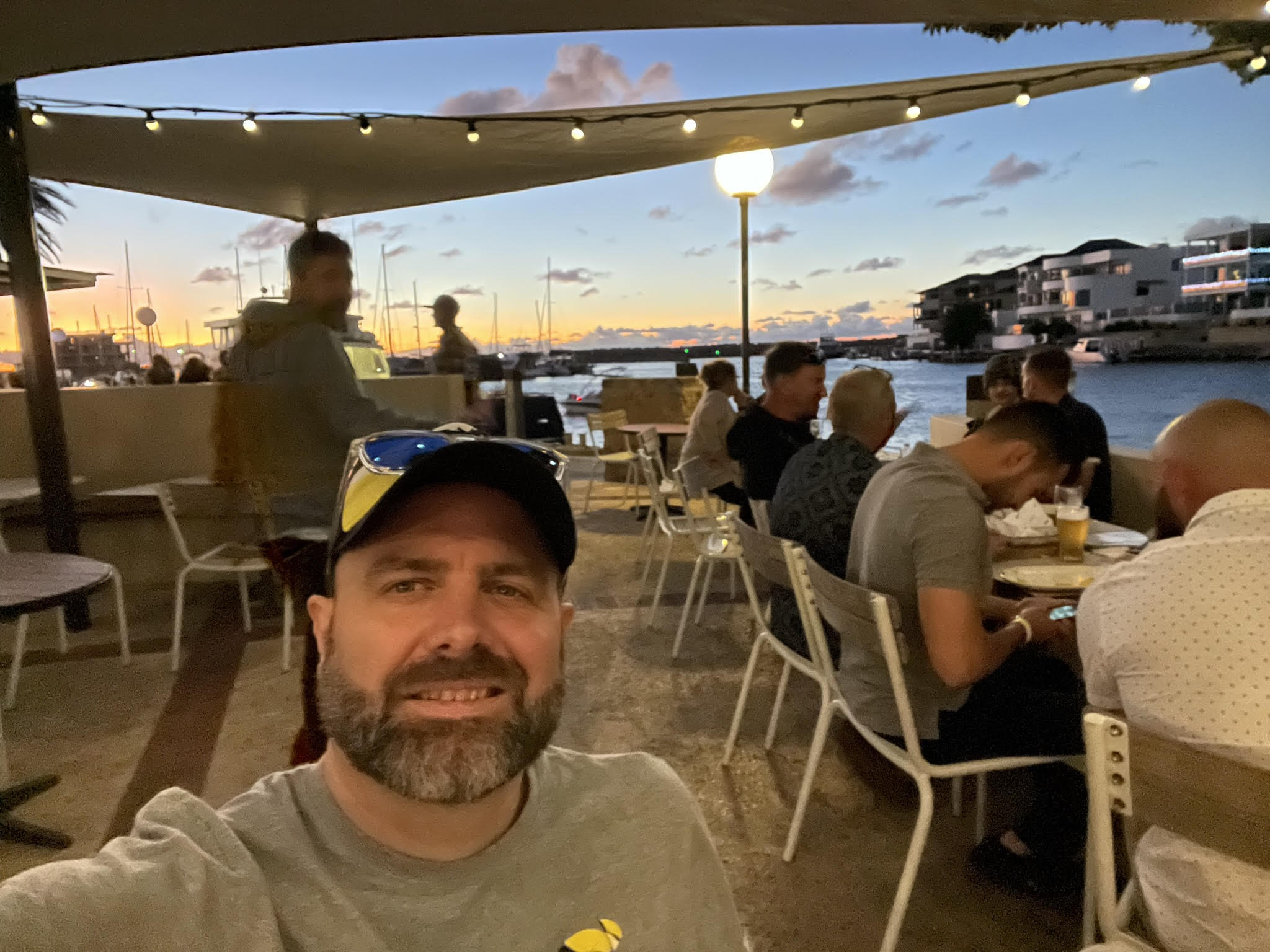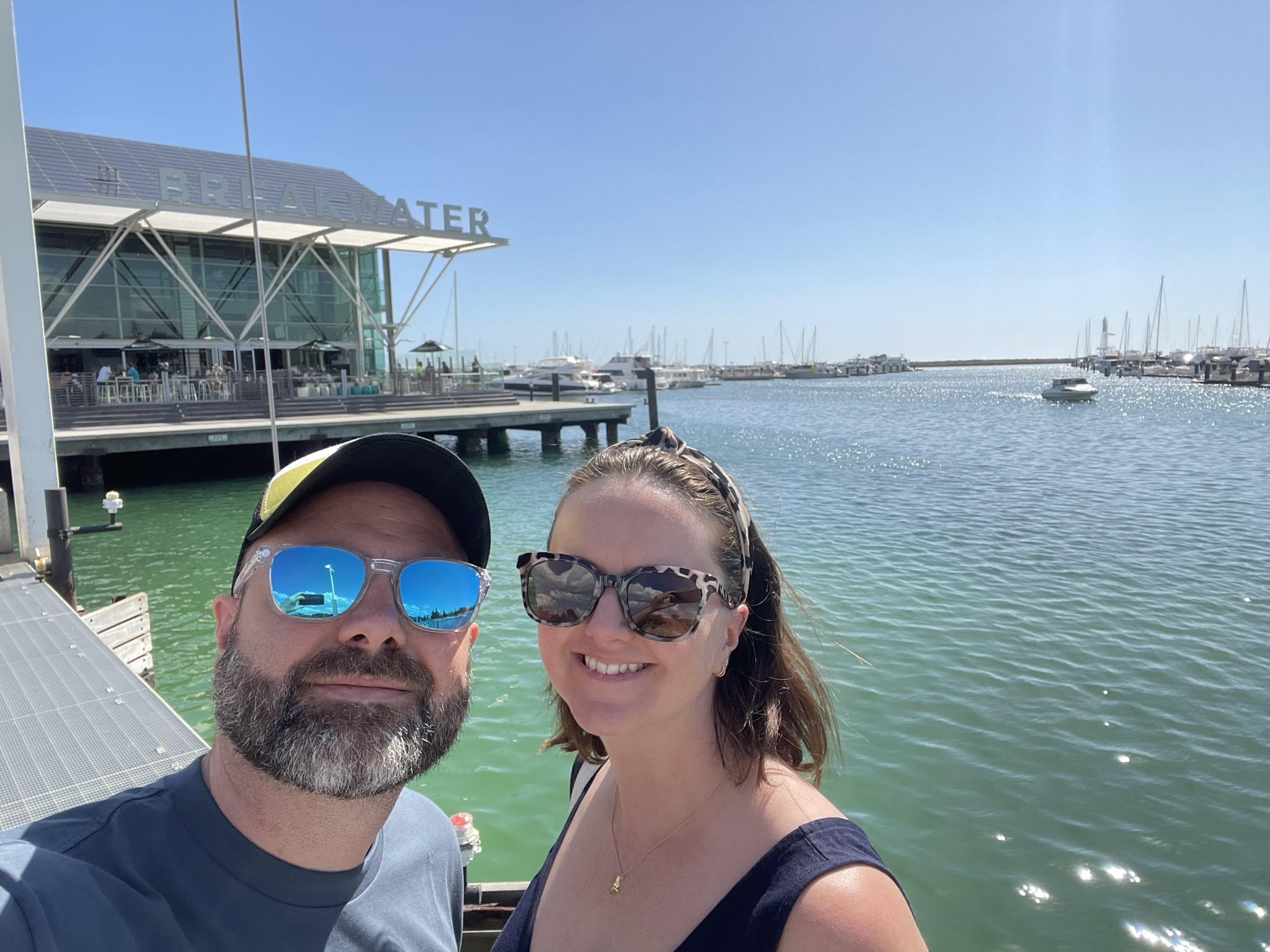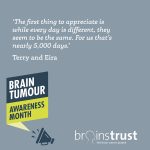In his inspiring story, Damon shares his strategies for not being defined by his diagnosis and how he went from feeling petrified to believing that “absolutely anything is possible”. We recognise that everyone is different and every brain tumour is different. Not all can be overcome or cured with lifestyle changes, but we can all make changes to our lives that enable us to be in control.
Damon’s story
 Hello, my name is Damon, I am 41 years old, and I live in Woking with my very lovely fiancée. I’m into food, wine, cycling, the Tour de France, wrestling from the mid-90s to mid-00s (although I don’t admit that too often!) and I sing and play the odd tune on my guitar. In December 2019 after some amnesia episodes that left me feeling a bit strange and scared, I was diagnosed with an Astrocytoma grade 2, and as strange as it might sound (or maybe it doesn’t?) it was the best thing that ever happened to me, although I didn’t always believe that.
Hello, my name is Damon, I am 41 years old, and I live in Woking with my very lovely fiancée. I’m into food, wine, cycling, the Tour de France, wrestling from the mid-90s to mid-00s (although I don’t admit that too often!) and I sing and play the odd tune on my guitar. In December 2019 after some amnesia episodes that left me feeling a bit strange and scared, I was diagnosed with an Astrocytoma grade 2, and as strange as it might sound (or maybe it doesn’t?) it was the best thing that ever happened to me, although I didn’t always believe that.
My diagnosis
It’s December 4th 2019, and it’s been a long and scary few days, and it’s not over yet. I’m sat in Dr Trends office with Mum and Dad waiting to hear what he has to say about “something” that has shown up on my scan. He looks solemn and sad as he tells me I have a large brain tumour growing on my right temporal lobe. I’d had the scan he requested; however, I’d forgotten to ask for a scan with contrast which would allow him to see what clarity it was, how aggressive it was- essentially whether it’s the “good type” or the “bad type”. He’s on the ball and has booked me in for a scan straightaway that will this time involve me being injected with the contrast solution part way through the MRI, and we are to come back at the same time tomorrow and go through this scan. He also sent me to the pharmacy as he was putting me on Keppra straight away. I hadn’t had a full seizure yet and so he wanted to help prevent this.
I now had epilepsy, had a brain tumour and I was absolutely petrified. Me, Mum, and Dad were all pretty silent, and the next 24 hours were sheer terror. The next day when we go back, he is smiling and is very quick to tell me that although the tumour is large, it is operable, low grade and slow growing, there is hope, and he’s already booked me in to see a surgeon early next week.
My surgeon was really reassuring and calm. He explained that glioma is Latin for “lump”. He reminded me that tumour aside, I am fit and healthy and so shouldn’t panic. He can operate and will “debulk” a large proportion of the tumour and will then be left with a residual mass that we monitor.
Surgery, scans, change of career and meeting the love of my life
It felt like there was hope, and this was all I needed to give me some positivity amongst the fear. Surgery went as well as expected on Feb 11th 2020, just before Covid. After surgery I was out on my bike 4 weeks later and getting back to fitness.
I had in this time decided that I was going to change careers, the diagnosis was just the nudge I needed. I’d been in recruitment for 15+ years and was running my own business. Time to move out of recruitment and into coaching and see where that would lead me. I didn’t know it at the time, but this was to prove a key change to my life that would help me later on with overcoming challenges and building a positive mindset.
During this time, I downloaded a dating app and met the love of my life! Life was good, in fact it was great, but with one burden that I was scared to address: what if my check-up scans show some growth?
It’s grown, treatment is up ahead.
My fears had come true. It was still growing slowly. Treatment was being talked about. Do I go for a clinical trial with a chance I’d be on the placebo, or stick to steady and proven radiotherapy followed by chemotherapy? My consultant was great and gave me advice when I needed to make decisions. Six weeks of radio, followed by six rounds of chemo would start in September, giving me the summer to get ready and enjoy…somehow! I was petrified though, and that lasted for around a month.
From petrified to believing that absolutely anything is possible!
Towards the end of June something happened. I went from being on my balcony crying my eyes out with my fiancée and us both wondering if I had a future, to thinking and believing that I could do anything if I put my mind to it. I was actually getting excited about turning growth and treatment from a challenge into an opportunity to grow. This didn’t come out of nowhere, I got some inspiration and hope. This came in two forms.
One was the book ‘Radical Remission – Surviving Cancer Against All Odds’ by Kelly Turner, recommended to me by my uncle. His friend had had aggressive colon cancer and had read the book, made some radical changes to his life, and now he was cancer free. And the evidence and stories in the book were just what I needed to hear, especially the two stories about brain tumour diagnoses. The book runs through 9 key factors that those who have survived cancer against the odds have in common, and they were all easily accessible. One was radically changing your diet, another was using herbs and supplements, and the other seven were all mental, emotional or spiritual. These were all things I could tap in to.
In addition to that, I’d been inspired to look into the Wim Hof Method. This man had practiced an ancient breathing technique as well as daily cold water exposure.
And that was it! I was off, within weeks I was practicing the Wim Hof Method daily, had read all of Radical Remission (and made notes) and I just started saying to myself a phrase that would serve me well over the next year:
“we can do anything, and I mean absolutely anything, including heal our bodies, when we put our minds to it!”
We are what we think- think amazing things, and they will happen.
I decided that I was going to embrace social media and document my progress through treatment using the “power of positivity” to prove to myself and anyone who followed me that we really could do anything if we put our minds to it.
It really helped me knowing that there were so many free and natural resources out there that could help me during and after treatment. These were things that would have a significant positive impact on the human body, mind and overall health.
This was all backed up by my coach training. The ultimate goal of coaching is getting people to believe in themselves, believe they are powerful beings and then take control of their lives! It embraced and encouraged positive thinking, with phrases like “how can you turn a challenge into a growth opportunity”- and that’s exactly what I did!
It got me excited! I’m not saying treatment was easy, but it was certainly easier than it could have been. And the science behind the Wim Hof Method was also proving to be great for minimising inflammation and side effects and giving me more energy all the way through treatment. I’d joined a “Wim Hof Cancer Survivors and Support Group” on Facebook and lots of people going pre, during and post treatment were practicing the Wim Hof Method and as a result having fewer and less severe side effects to treatment.
After treatment, lightbulb moment, WHI and brainstrust
 Once treatment finished in July 2022, I started working on recovery, healing and feeling fit again. My coaching business was growing, and I was enjoying my work. When your job is to support and empower people to create a positive mindset and make positive changes to their life, it helps you on your healing journey.
Once treatment finished in July 2022, I started working on recovery, healing and feeling fit again. My coaching business was growing, and I was enjoying my work. When your job is to support and empower people to create a positive mindset and make positive changes to their life, it helps you on your healing journey.
The part I struggled with post treatment was that there was still something up there in my head. Other types of cancer get to ring a bell and get the ‘all clear’, but I didn’t. And then I had a lightbulb moment, it didn’t matter if there was something still up there. If I do really believe in the power of the body and the mind, then I needed to trust the universe. What mattered was my belief system, my thoughts and actions on a daily basis, being positive, having fun and living life. The more you live your life, the more you live. Now when people ask me if I have the all clear, I tell them:
“If you were to ask a doctor they would say you were in stable state, and so technically not in the all clear, but if you ask me, I have the all clear the minute I decide I have the all clear, we are what we think.”
I am now going through my training to become a Wim Hof Instructor so that I can share the method with others, as I believe in the method so much. Here is a blog I wrote about this part of my journey.
I am now at the stage whereby I really want to share all that I have learnt on my brain tumour journey, and give back to the community. With that in mind it was perfect timing when I bumped into the lovely Molly and Laura from brainstrust at a brain tumour conference I’d been asked to speak at. Combining my coaching qualifications and experience with the learnings of my brain tumour journey, I really feel I can support others come to terms with where they are at, and then help them start to take powerful, positive action and live their best life, and heal! When Molly enquired whether I would be interested in supporting the charity, I jumped at the chance! In fact, she hadn’t even enquired, and I was saying I’d love to help them! It feels like I have found a missing link to my life now that I can give back through brainstrust.
So, what are the things that really helped me go from absolute terror wondering if I would live to see 50, to a place where by I believe that my brain tumour diagnosis is the best thing that’s ever happened to me?
- This is probably an obvious one, Friends and family being so supportive! Even the love on social media from people you don’t know that well!
- My consultants and all the healthcare professionals I have met have been so kind, caring, open minded and encouraging! “If it makes you feel good, do it!”
- Changing my career, becoming a coach – this has become my passion, and the value of that is second to none for my health.
- Changing my mindset and belief system Looking for the love in the world. Being love and loving energy – this was and is at the heart of my belief and mindset – I even wrote a blog about how I am now showing my tumour love, do I sound bonkers yet?!
- The WHM – I believe in this that much that I am now training to be a Wim Hof Instructor!
- I have a dog, and he has been such great company! He has also got me out of the house and into nature, even if it was a slow walk, getting the blood pumping, a change of scenery and some fresh air are great for the mind, body and soul.
- The book Radical Remission helped me realise I have so many choices, as well as so much in my control- we all do. There are some great books out there now from people who have been on the most challenging of cancer journeys and come through stronger, if one person can do it, we can all do it.
I’m looking forward to spreading the love and positivity throughout the world, love is healing, it really is.
Much love,
Damon






